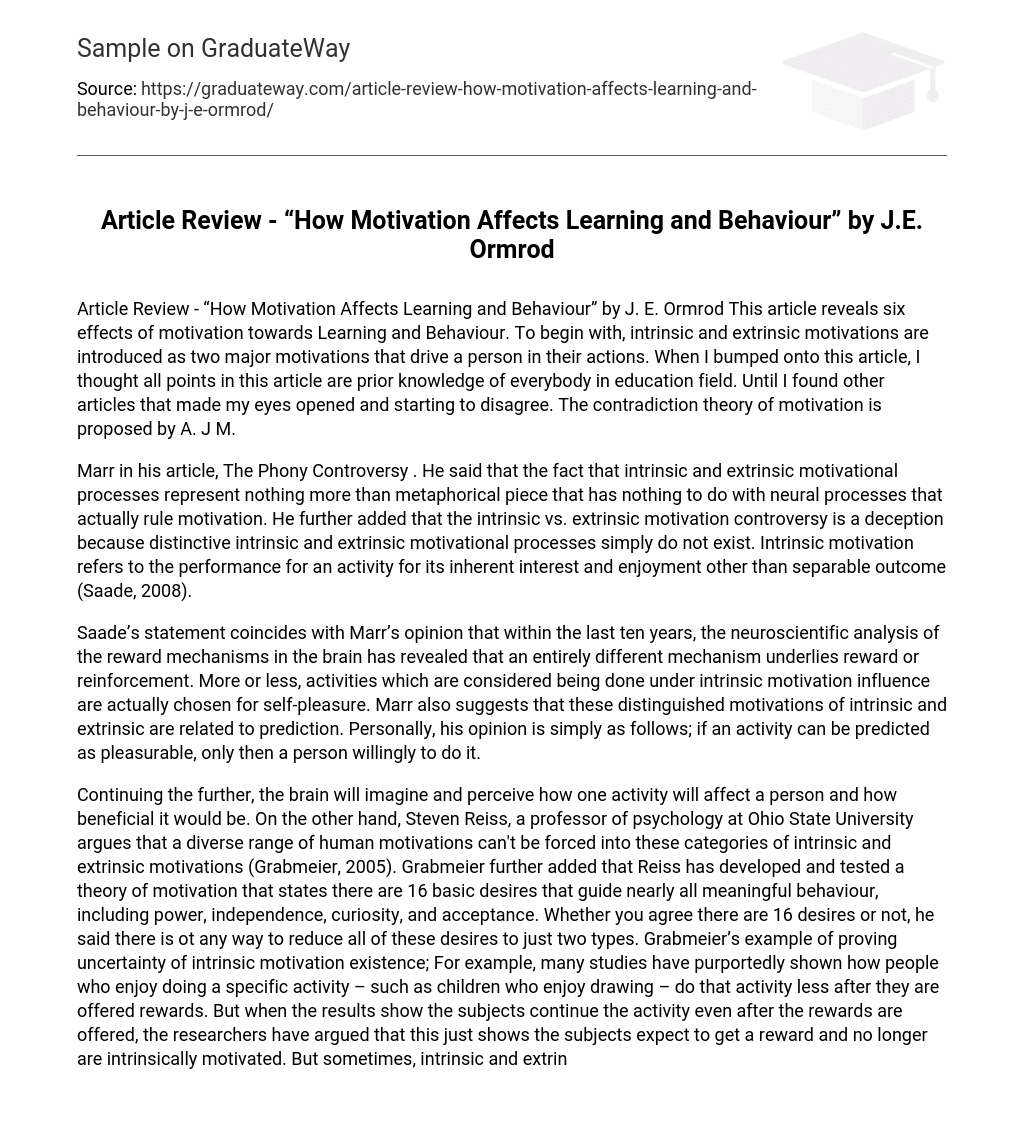Article Review – “How Motivation Affects Learning and Behaviour” by J. E. Ormrod This article reveals six effects of motivation towards Learning and Behaviour. To begin with, intrinsic and extrinsic motivations are introduced as two major motivations that drive a person in their actions. When I bumped onto this article, I thought all points in this article are prior knowledge of everybody in education field. Until I found other articles that made my eyes opened and starting to disagree. The contradiction theory of motivation is proposed by A. J M.
Marr in his article, The Phony Controversy . He said that the fact that intrinsic and extrinsic motivational processes represent nothing more than metaphorical piece that has nothing to do with neural processes that actually rule motivation. He further added that the intrinsic vs. extrinsic motivation controversy is a deception because distinctive intrinsic and extrinsic motivational processes simply do not exist. Intrinsic motivation refers to the performance for an activity for its inherent interest and enjoyment other than separable outcome (Saade, 2008).
Saade’s statement coincides with Marr’s opinion that within the last ten years, the neuroscientific analysis of the reward mechanisms in the brain has revealed that an entirely different mechanism underlies reward or reinforcement. More or less, activities which are considered being done under intrinsic motivation influence are actually chosen for self-pleasure. Marr also suggests that these distinguished motivations of intrinsic and extrinsic are related to prediction. Personally, his opinion is simply as follows; if an activity can be predicted as pleasurable, only then a person willingly to do it.
Continuing the further, the brain will imagine and perceive how one activity will affect a person and how beneficial it would be. On the other hand, Steven Reiss, a professor of psychology at Ohio State University argues that a diverse range of human motivations can’t be forced into these categories of intrinsic and extrinsic motivations (Grabmeier, 2005). Grabmeier further added that Reiss has developed and tested a theory of motivation that states there are 16 basic desires that guide nearly all meaningful behaviour, including power, independence, curiosity, and acceptance. Whether you agree there are 16 desires or not, he said there is ot any way to reduce all of these desires to just two types. Grabmeier’s example of proving uncertainty of intrinsic motivation existence; For example, many studies have purportedly shown how people who enjoy doing a specific activity – such as children who enjoy drawing – do that activity less after they are offered rewards. But when the results show the subjects continue the activity even after the rewards are offered, the researchers have argued that this just shows the subjects expect to get a reward and no longer are intrinsically motivated. But sometimes, intrinsic and extrinsic motivation can be coincidentally in one situation.
For instance, Farris is a Guitar Hero game addict and one day he found out the game is promoted on a fun fair. He played on his best and scored the highest mark because he is naturally likes that game. The second reason is a girl beaten him on that game previously. There Are No Effects without Causes Nevertheless, it is impossible to claim that motivation doesn’t exist while its effects are being explained in detail in the stated article. Effects of motivation as suggested by Ormrod ; 1. Motivation directs behaviour toward particular goals 2. Motivations leads to increased effort and energy 3.
Motivation increases initiation and persistence in activities 4. Motivation affects cognitive processes 5. Motivation determines which consequences are reinforcing and punishing 6. Motivation often enhances performances. We are jumping into fifth effect which is emphasizing on reinforcement. Reinforcement itself means the process of encouraging or establishing a belief or pattern of behaviour . To be truth, Ormrod’s opinion can be agreed because encouragement to success in study achievement is basically innate in every student. In addition, success is a typical needs and rather important nowadays.
In order to be successful in academic, they have to be attentive in classes, this where motivations in learning simply described. Learning session can be boring as they get older. Thus, motivation is which can trigger study’s passion. This statement is supported by sixth effect of motivation in leaning. Because people are doing action for reasons and motivation is a medium to put reasons into reality. Students give different reasons for their success or failure in various school subjects and these reasons are consistent with their self-concept ability in that domain (Boekaerts, 2002).
In my opinion, students who consider learning session as a pleasurable session can be the most motivated students. Thus they will give out their best performance. This is where extrinsic motivation is logically can be one’s trigger. If by any chance intrinsic motivation is proved not exist, the same question would be for extrinsic motivation. Because other than prediction and desires, we still need a trigger and it seems suit to be called ‘motivation’. Or else, let’s we pick other name and psychological term for it.





